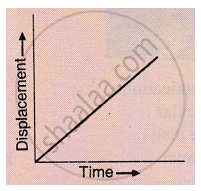Advertisements
Advertisements
प्रश्न
Write three equations of uniformly accelerated motion relating the initial velocity (u), final velocity (v), time (t), acceleration (a) and displacement (S).
उत्तर
Three equations of a uniformly accelerated motion are
v = u + at
s = ut + (1/2)at2
v2 = u2 + 2as
APPEARS IN
संबंधित प्रश्न
A train starting from a railway station and moving with uniform acceleration attains a speed 40 km h−1 in 10 minutes. Find its acceleration.
Which of the two can be zero under certain conditions : average speed of a moving body or average velocity of a moving body ?
What conclusion can you draw about the velocity of a body from the displacement-time graph shown below :

Explain why, the motion of a body which is moving with constant speed in a circular path is said to be accelerated.
A train travelling at 20 m s-1 accelerates at 0.5 m s-2 for 30 s. How far will it travel in this time ?
A body starts from rest and acquires a velocity 10 m s-1 in 2 s. Find the acceleration.
For a uniformly retarded motion, the velocity-time graph is _____________
What do you understand by the term acceleration?
A stone thrown vertically upwards takes 3 s to attain maximum height. Calculate
- initial velocity of the stone
- maximum height attained by the stone. (Take g = 9.8 ms−2)
The velocity-time graph (Fig. 8.5) shows the motion of a cyclist. Find (i) its acceleration (ii) its velocity and (iii) the distance covered by the cyclist in 15 seconds.

